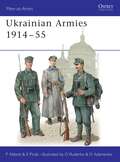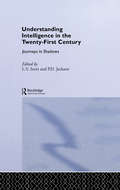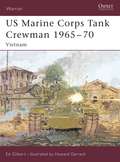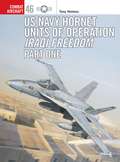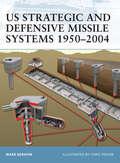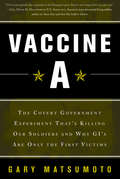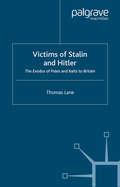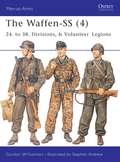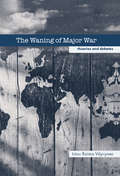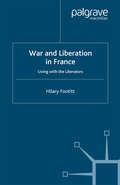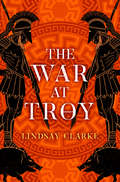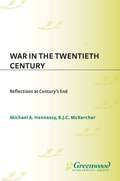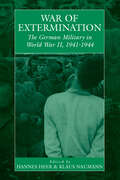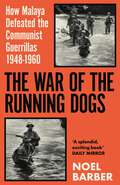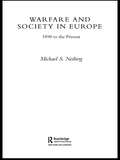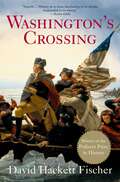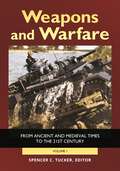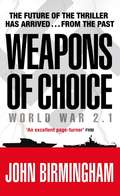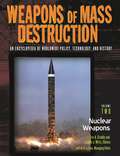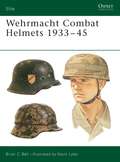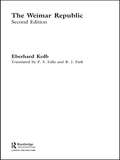- Table View
- List View
Ukrainian Armies 1914–55 (Men-at-Arms #412)
by Peter Abbott Eugene PinakThere can be no region in Europe whose history has been more tortured than Ukraine. During the 20th century Austria, Poland, Russia, Germany, Hungary, Czechoslovakia and Romania vied for power over parts of this vast and fragmented area; and its divided peoples rose time and again in vain attempts to win their independence. For the first time in the West, this book gives a succinct summary of all the different armed forces raised among the Ukrainians, and of their uniforms and insignia. These are illustrated in colour and in a selection of extremely rare photographs, dating from the Great War to the aftermath of World War II, when Ukrainian guerrillas continued to defy the Soviet authorities until the mid-1950s.
Understanding Intelligence in the Twenty-First Century: Journeys in Shadows
by Peter Jackson L. V. ScottOver the past few decades, international history and security have been significantly influenced by greater understanding of the role of intelligence in national security and foreign policy-making. In Britain, much of the work has developed in the subdiscipline of international history with its methodological predisposition towards archive-ba
Understanding Intelligence in the Twenty-First Century: Journeys in Shadows (Studies In Intelligence Ser.)
by L. V. Scott P. D. JacksonOver the past few decades, international history and security have been significantly influenced by greater understanding of the role of intelligence in national security and foreign policy-making. In Britain, much of the work has developed in the subdiscipline of international history with its methodological predisposition towards archive-ba
US Marine Corps Tank Crewman 1965–70: Vietnam (Warrior #90)
by Ed GilbertBy 1960, following Korea, tanks and their crews had proved themselves to be a fundamental part of the Marine Corps' combined arms team. When the Marines were ordered to Vietnam in 1965, they took their tanks with them. This book explores this decision, which created a political storm. The presence of the tanks became a lightning rod for accusations of an 'escalation' of the war. Nevertheless, the tanks not only proved their value in the anti-guerrilla campaigns, but also amid the bitter conventional fighting and extraordinary casualties at Hue City. The ability to undertake such radical change and to prevail demonstrated the versatility, courage and tenacity that are the hallmarks of the 'ordinary' Marine.
US Navy Hornet Units of Operation Iraqi Freedom (Combat Aircraft #46)
by Tony Holmes Chris DaveyThe F/A-18 Hornet in its various guises was the 'universal soldier' of OIF, with around 250 seeing combat. Flown by various squadrons and groups, the Hornet attacked a range of targets including tanks of the various Iraqi Republican Guard units and government buildings housing elements of the Baath party regime. Apart from its ability to drop precision munitions such as laser-guided bombs, the Hornet was also capable of launching anti-radar missiles and acting as an aerial tanker and reconnaissance platform for other strike types. This book explores the Hornet's versatility which has enhanced its reputation as one of the world's leading strike-fighter aircraft.
US Strategic and Defensive Missile Systems 1950–2004 (Fortress #36)
by Mark BerhowFor 40 years following the end of World War II, the Western democratic governments and the Eastern Bloc Communist powers were locked in the ideological, political, and economic struggle of the Cold War. The United States and the Soviet Union developed missile systems capable of delivering conventional and nuclear explosives against enemy massed bomber formations in the air, and of delivering retaliatory nuclear payloads against ground targets located on distant continents. The missile systems played both a defensive role, and a potential offensive role, which was parlayed to the public as deterrence against attack by the rival bloc. This title provides a detailed overview of the fixed-launch-site strategic missile systems of the United States.
Vaccine A: The Covert Government Experiment That's Killing Our Soldiers--and Why GI's Are Only the First Victim
by Gary MatsumotoIn this provocative look at the US military from the Persian Gulf War through the 2003 invasion of Iraq, investigative journalist Gary Matsumoto contends that an anthrax vaccine dispensed by the Department of Defense was the cause of Gulf War Syndrome and the origins of a massive cover-up. Matsumoto calls it the worst friendly-fire incident in military history. A skillfully-woven narrative that serves as a warning about this man-made epidemic, Vaccine A is a much needed account of just what went wrong, and why.
Victims of Stalin and Hitler: The Exodus of Poles and Balts to Britain
by T. LaneIn contemporary Britain there are substantial ethnic minorities of Polish and Baltic origin, who arrived here shortly after World War II. Using official records and the words of survivors and their children, the author explores the reasons for their savage uprooting at the hands of Stalin and Hitler, their subsequent odysseys, and the reasons for their resettlement in Britain. This is a study of totalitarianism, political asylum, and the relationship of ethnic minorities to the host society, combining first-hand accounts with historical analysis.
The Waffen-SS: 24. To 38. Divisions, And Volunteer Legions (Men-at-arms Ser. #420)
by Gordon WilliamsonIn 1944–45 the Waffen-SS formed many nominal 'divisions' from a motley range of sources, whose battlefield value was as varied as their backgrounds. The best were built around existing Western European volunteer regiments; some, raised from Central Europeans and Russians, were strong in numbers but weak in morale; some were of negligible size, scraped together from remnants and trainees; and some were sinister 'anti-partisan' gangs, assembled from the military dregs of the Eastern Front. Illustrated with rare photographs from private collections and meticulous colour artwork, this final title in our sequence details their organisation, uniforms and insignia, and summarises their battle records.
The Waning of Major War: Theories and Debates (Contemporary Security Studies)
by Raimo VäyrynenThis book is a systematic effort by leading international scholars to map the trends in major-power warfare and explore whether it is waxing or waning. The main point of departure is that major-power war as a historical institution is in decline. This does not mean, though, that wars between states are in general disappearing. While there is some convergence in the conclusions by individual authors, they are by no means unanimous about the trend. The articles explore different causes and correlates of the declining trend in major-power warfare, including the impact of the international structure, nuclear weapons, international law, multilateral institutions, sovereignty and value changes.
The Waning of Major War: Theories and Debates (Contemporary Security Studies)
by Raimo VayrynenThis book is a systematic effort by leading international scholars to map the trends in major-power warfare and explore whether it is waxing or waning. The main point of departure is that major-power war as a historical institution is in decline. This does not mean, though, that wars between states are in general disappearing. While there is some convergence in the conclusions by individual authors, they are by no means unanimous about the trend. The articles explore different causes and correlates of the declining trend in major-power warfare, including the impact of the international structure, nuclear weapons, international law, multilateral institutions, sovereignty and value changes.
War and Liberation in France: Living with the Liberators
by H. FootittThis book, coinciding with the sixtieth anniversary of the Liberation of France, takes a unique approach to the events of 1944, by seeing them as shared experiences which brought ordinary Anglo-Americans and French people into contact with each other in a variety of different communities. The book looks at the Liberation through 5 case-studies: Normandy, Cherbourg, Provence, the Pyrénées-Orientales and Reims, and uses the words of participants at the time to describe the developing relationship between Liberators and Liberated.
The War at Troy (The Troy Quartet #2)
by Lindsay ClarkePART TWO OF THE TROY QUARTET Bringing ancient myth to life with passion, humour, and humanity, Lindsay Clarke vividly retells the story of Troy and of the heroes who fought there.
War in the Twentieth Century: Reflections at Century's End (Praeger Studies in Diplomacy and Strategic Thought)
by Michael A. Hennessy B. J. C. MckercherWar proved a seminal influence on the shape of the 20th century. This collection provides various essays addressing the phenomenon of war as viewed through the eyes of the fin de siecle. Leading scholars of war, international relations, and international law offer general or specific insights into war's consequences during the last one hundred years. Combined, the essays demonstrate the centrality of 20th century war to the development of the modern state system, international jurisprudence, and contemporary society.Donald Watt provides an overview of the use of the term war in its legal and practical sense. John Lynn addresses the transformation of military professional forces through the century. Donna Arzt explores the slow convergence of humanitarian law with human rights laws as witnessed in the latter half of the century. The contours of the national security state that emerged in many forms through the late century are detailed in contributions by Lawrence Aronsen, Geoffrey Smith, and Gary Hess. Finally, efforts to avert war through arms control, disarmament, arms reduction, and peace-keeping are examined in essays by Norman Hillmer and Erik Goldstein.
War of Extermination: The German Military in World War II (War and Genocide #3)
by Hannes Heer Klaus NaumannAmong the many myths about the relationship of Nazism to the mass of the German population, few proved more powerful in postwar West Germany than the notion that the Wehrmacht had not been involved in the crimes of the Third Reich. Former generals were particularly effective in spreading, through memoirs and speeches, the legend that millions of German soldiers had fought an honest and "clean" war and that mass murder, especially in the East, was entirely the work of Himmler's SS. This volume contains the most important contributions by distinguished historians who have thoroughly demolished this Wehrmacht myth. The picture that emerges from this collection is a depressing one and raises many questions about why "ordinary men" got involved as perpetrators and bystanders in an unprecedented program of extermination of "racially inferior" men, women, and children in Eastern Europe and the Soviet Union during the Second World War. Those who have seen these terrible photos of mass executions and other atrocities, currently on show in an exhibition in Germany and soon to be in the United States, will find this volume most enlightening.
The War of the Running Dogs: Malaya 1948-1960 (Sven Hassel War Classics)
by Noel Barber'The story of the first all-out struggle in Asia between Communism and the West, vividly told in an exciting and engrossing book' Sunday ExpressOnly three short years after the end of the Japanese occupation, war came again to Malaya. The Chinese-backed guerrillas called it the War of the Running Dogs - their contemptuous term for those in Malaya who remained loyal to the British. The British Government referred to this bloody and costly struggle as the 'Malayan Emergency'. Yet it was a war that lasted twelve years and cost thousands of lives. By the time it was over Malaya had obtained its independence - but on British, not on Chinese or Communist terms. Here is the war as it was. Here are the planters and their wives on their remote rubber estates, the policemen, the generals and the soldiers, the Malays, Chinese and Indians of a polyglot country, all fighting an astute, ruthless, and well organized enemy.
Warfare and Society in Europe: 1898 to the Present (Warfare And History Ser.)
by Michael S. NeibergWarfare and Society in Europe, 1898 to the Present examines warfare in Europe from the Fashoda conflict in modern-day Sudan to the recent war in Iraq. The twentieth century was by far the world's most destructive century with two global wars marking the first half of the century and the constant fear of nuclear annihilation haunting the second half
Warfare and Society in Europe: 1898 to the Present
by Michael S. NeibergWarfare and Society in Europe, 1898 to the Present examines warfare in Europe from the Fashoda conflict in modern-day Sudan to the recent war in Iraq. The twentieth century was by far the world's most destructive century with two global wars marking the first half of the century and the constant fear of nuclear annihilation haunting the second half
Washington's Crossing (Pivotal Moments in American History)
by David Hackett FischerSix months after the Declaration of Independence, the American Revolution was all but lost. A powerful British force had routed the Americans at New York, occupied three colonies, and advanced within sight of Philadelphia. Yet, as David Hackett Fischer recounts in this riveting history, George Washington--and many other Americans--refused to let the Revolution die. On Christmas night, as a howling nor'easter struck the Delaware Valley, he led his men across the river and attacked the exhausted Hessian garrison at Trenton, killing or capturing nearly a thousand men. A second battle of Trenton followed within days. The Americans held off a counterattack by Lord Cornwallis's best troops, then were almost trapped by the British force. Under cover of night, Washington's men stole behind the enemy and struck them again, defeating a brigade at Princeton. The British were badly shaken. In twelve weeks of winter fighting, their army suffered severe damage, their hold on New Jersey was broken, and their strategy was ruined. Fischer's richly textured narrative reveals the crucial role of contingency in these events. We see how the campaign unfolded in a sequence of difficult choices by many actors, from generals to civilians, on both sides. While British and German forces remained rigid and hierarchical, Americans evolved an open and flexible system that was fundamental to their success. The startling success of Washington and his compatriots not only saved the faltering American Revolution, but helped to give it new meaning.
Weapons and Warfare [2 volumes]: From Ancient and Medieval Times to the 21st Century [2 volumes] (Weapons And Warfare Ser.)
by Spencer C. TuckerThis work covers major weapons throughout human history, beginning with clubs and maces; through crossbows, swords, and gunpowder; up to the hypersonic railgun, lasers, and robotic weapons under development today.Weapons and Warfare is designed to provide students with a comprehensive and highly informative overview of weapons and their impact on the course of human history. In addition to providing basic factual information, this encyclopedia will delve into the greater historical context and significance of each weapon. The chronological organization by time period will enable readers to fully understand the evolution of weapons throughout history.The work begins with a foreword by a top scholar and a detailed introductory essay by the editor that provides an illuminating historical overview of weapons. It then offers entries on more than 650 individual weapons systems. Each entry has sources for further reading. The weapons are presented alphabetically within six time periods, ranging from the prehistoric and ancient periods to the contemporary period. Each period has its own introduction that treats the major trends occurring in that era. In addition, 50 sidebars offer fascinating facts on various weapons. Numerous illustrations throughout the text are also included.
Weapons of Choice: World War 2.1 - Alternative History Science Fiction (The\axis Of Time Trilogy #Bk. 1)
by John BirminghamThe impossible has spawned the unthinkable. In 2021, a quantum military experiment goes horrifically wrong. A multinational taskforce of ultra-modern warships is suddenly transported back in time to 1942... right into the path of the US naval battle group bound for Midway Atoll. History is rewritten in an instant as the future smashes into the past, and high-tech hardware goes head to head with World War Two technology. In the chaos that ensues, thousands are killed, but the maelstrom has only just begun. The veterans of Pearl Harbour have never seen a helicopter, or a cruise missile - let alone nanotechnology, ceramic bullets, and F22 Raptor stealth jetfighters. Allied and Axis forces are then caught in a desperate struggle to gain the upper hand - each hoping to tip the balance with a fist full of twenty first century firepower. What happens next is anybody's guess - and everybody's nightmare...
Weapons of Mass Destruction [2 volumes]: An Encyclopedia of Worldwide Policy, Technology, and History [2 volumes]
by Jeffrey A. Larsen James J. Wirtz Eric A. CroddyThe first accessible reference to cover the history, context, current issues, and key concepts surrounding biological, chemical, and nuclear weapons.A collection of information on everything from aerosols to zones of peace, these two volumes cover historical background, technology, and strategic implications of biological, chemical, and nuclear weapons, thus providing facts, terms, and context needed to participate in contemporary policy debate. This encyclopedia is the only comprehensive reference dedicated to the three types of weapons of mass destruction.With over 500 entries arranged alphabetically, volume one covers biological and chemical weapons, while volume two focuses on nuclear weapons. Experts from eight countries cover issues related to these weapons, policies, strategies, technologies, delivery vehicles, arms control concepts, treaties, and key historical figures and locations. Entries are written to make difficult concepts easy to understand by cutting through military and scientific jargon. Students, lay readers, scientists, and government policy makers are provided with the broad range of information needed to place today's policy discussions in proper strategic or historical context.
Wehrmacht Combat Helmets 1933–45 (Elite #106)
by Brian C BellThe German Stahlhelm is perhaps the most recognizable image of World War II. Manufactured in its millions, it was used or copied by many countries. It is still one of the most collected relics of the war; but despite its relative availability, prices have reached levels that challenge collectors to protect themselves by acquiring in-depth knowledge. This book, by a collector of 30 years' standing, offers a detailed masterclass in the patterns, component parts and finishes of the combat helmets used by the German Army, Navy and Air Force. It is illustrated with a superb selection of rare period photos, colour photos of collected examples, and striking colour paintings.
The Weimar Republic
by Eberhard KolbIn the first part of the book, Professor Kolb provides a clear historical narrative of the political, social, economic and cultural developments of the Weimar Republic, setting it within the international context of the inter-war period. In the second part he surveys and analyses scholarly research in the field which sheds light on the problems and controversies of the period in home and foreign affairs. This text, therefore, provides an excellent introduction to the history of the Weimar Republic and a guide to the state of research for more advanced students.The book contains a detailed chronology and an extensive and up-to-date bibilography, divided by subject, which includes recent English-language studies of the period and translation of German works.
The Weimar Republic
by Eberhard KolbIn the first part of the book, Professor Kolb provides a clear historical narrative of the political, social, economic and cultural developments of the Weimar Republic, setting it within the international context of the inter-war period. In the second part he surveys and analyses scholarly research in the field which sheds light on the problems and controversies of the period in home and foreign affairs. This text, therefore, provides an excellent introduction to the history of the Weimar Republic and a guide to the state of research for more advanced students.The book contains a detailed chronology and an extensive and up-to-date bibilography, divided by subject, which includes recent English-language studies of the period and translation of German works.
